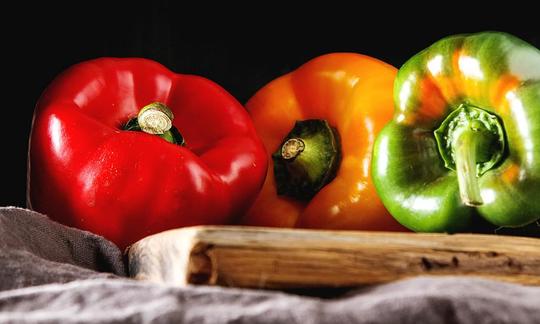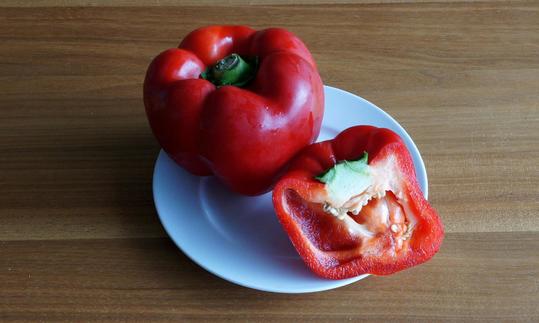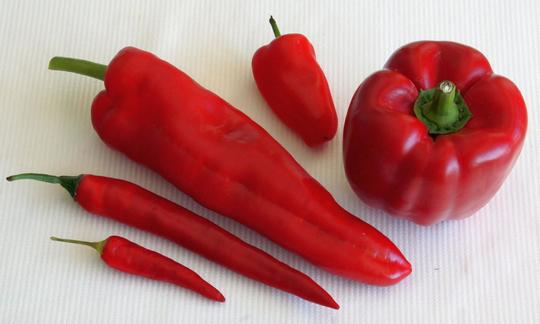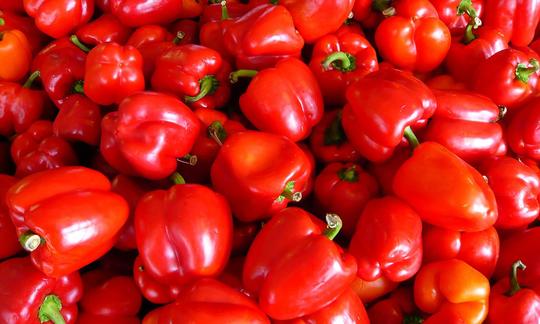Table of contents
The red bell pepper ( organic ) tastes mildly sweet when raw . The plant belongs to the genus Paprika (also: Spanish pepper, Capsicum annuum L.) from the nightshade family (Solanaceae). The high vitamin C content and the antioxidants it contains make the red bell pepper very healthy.
Red bell peppers - Use in the kitchen:
In contrast to green bell peppers, red or yellow bell peppers have a distinct sweetness. Red bell peppers taste fresh and crisp when eaten raw as a snack, chopped up in a homemade dip or in a raw vegetable salad. Whether grilled, pan-fried or braised, red bell peppers can be used in many different ways in the kitchen. They can be filled with grains (e.g. wholegrain rice , couscous ) or grain-like products ( quinoa ) and baked in the oven. Red bell peppers are also suitable for pickling and fermenting.
Tomatoes , potatoes , lettuce (e.g.lettuce ), eggplant , zucchini or onions also go well with this sweet and mild fruit. Spices and herbs such as basil , oregano , chili powder , garlic and rosemary also harmonize very well with the taste of red peppers. You can find many sweet pepper recipes on the internet, including for raw food.
The Scoville value of sweet peppers, which indicates the degree of spiciness, is very low at 0-10 Scoville units, as they contain very little capsaicin compared to other varieties. 3 Sweet peppers are therefore primarily used in cooking and not in medicine. You can find more information on the Scoville scale under hotter ingredients such as chili peppers, red and green , or jalapeños .
Paprika powder , which is made from dried peppers, is a popular spice. Depending on the variety chosen, the paprika powder can have different degrees of spiciness. The most common varieties in our country are rose hot (rose paprika), semi-sweet and noble sweet . Paprika powder can be used to season different dishes.
Vegan recipe for red pepper rice pan:
Ingredients (for 2 people): 200 g long grain rice, white , or whole grain rice (organic), 200 g cherry tomatoes , 3 red bell peppers (organic), 4 tbsp water , 2 tbsp cream cheese (vegan), 1 tsp paprika powder (sweet) , salt ,black pepper .
Preparation: Cook the rice according to the instructions on the packet. Meanwhile, wash the raw peppers (or bell peppers), halve them, remove the seeds and cut them into fine cubes. Wash and halve the cherry tomatoes and sauté them in a pan with the red pepper cubes for a few minutes. Add the vegan cream cheese and water and stir in. This should create a creamy sauce, which you can then season with salt, pepper and paprika powder. Add the finished, drained rice and serve the vegan pepper rice pan warm.
Vegan recipes with red bell peppers can be found under the note: " Recipes that have the most of this ingredient ".
| Not only vegans or vegetarians should read this: Vegans often eat unhealthily. Avoidable nutritional mistakes . |
Shopping - where to buy red bell peppers?
Red bell peppers are available all year round in supermarkets and at major retailers such as Coop , Migros , Denner , Volg , Spar , Aldi , Lidl , Rewe , Edeka , Hofer etc. In Central Europe, they are in season from July to October , and a little earlier for greenhouse crops. Organic raw bell peppers are available in organic shops and organic supermarkets ( Denn's Biomarkt and Alnatura ). or specialty stores. Some supermarkets also offer raw organic peppers. When shopping, look for a bright color, a firm, shiny and smooth surface and a fresh, green stem. Dull and glassy spots indicate the beginnings of rot.
Storage:
Fresh, red bell peppers should not be stored in the refrigerator as they are very sensitive to cold. The ideal storage temperature is 7-8 °C. Then the storage time is about 1 week for red peppers and 2-3 weeks for green peppers . 1 Red bell peppers will last about 2-3 days at room temperature. However, a cellar or a dark, unheated room is best for storage. Cooked red peppers should be stored in the refrigerator and used within a few days.
Red pepper ingredients - nutritional values - calories:
100 g of raw red bell peppers have 31 kcal. Red bell peppers have a water content of around 93%. With 0.3 g fat and 0.99 g protein per 100 g, red bell peppers are very low in fat and protein. The carbohydrate content is also very low at 6 g/100g.
The amount of vitamin C (ascorbic acid) covered by 100 g of red bell pepper covers around 160% of the daily requirement. The content of 128 mg/100g can be compared with kale (120 mg/100g). Green chili peppers (242.5 mg/100g) and yellow bell peppers (183.5 mg/100g) contain a lot of the vitamin. 2
Depending on the type of pepper, the vitamin C content varies considerably, but it has been scientifically proven that it gradually increases as the pepper ripens. 16
The folate (folic acid) content in red bell peppers (46 µg/100g) is comparable to that of mango (43 µg) or velvet foot mushrooms (48 µg). Legumes usually contain a lot of folic acid, but a large part of it is lost during the cooking process. Dried herbs, such as dried wild garlic ( 551 µg/100g), also contain a considerable amount of this valuable vitamin. 2
Is raw pepper healthy? Raw peppers contain not only the vitamin C mentioned above, but also B vitamins ( pyridoxine , biotin , riboflavin ), vitamin E , provitamin A (beta-carotene) and minerals in small amounts. The nutritional values (nutrients) of peppers make the fruit very healthy when raw.
The complete ingredients of red bell peppers, the coverage of the daily requirement and comparison values with other ingredients can be found in our bell pepper pictogram - nutrient tables in the CLICK FOR under the ingredient picture.
Health aspects - effects:
Are red peppers unhealthy? Due to the high vitamin C content in sweet peppers (red), the answer to this question is clearly "no". The ascorbic acid contained is more than twice as high as in a lemon (51 mg/100g). This vitamin protects folic acid, vitamin E and LDL particles (lipoproteins) in the blood from oxidation and converts copper into forms that can be used by enzymes. It also promotes the absorption of iron from plant-based foods. A sufficient intake of vitamin C can prevent heart attacks and improve circulatory problems. Organic peppers have an even higher proportion of secondary plant substances (especially phenols and carotenoids) and vitamin C. 4
Red peppers in particular contain high amounts of carotenoids: for example, beta-carotene, which the body converts into vitamin A , and the carotenoid lycopene. Green peppers have particularly high levels of phenolic acids, and yellow peppers contain many flavonoids. Flavonoids act as antioxidants and anti-inflammatory agents. 6 The bioactive compounds contained in peppers can have a positive effect against Alzheimer's. 5
In sweet bell peppers, the capsaicin content is only 0.1%, while in hot bell peppers it is 1% or more. In small quantities, capsaicin stimulates the appetite and aids digestion, but in large quantities it can irritate the skin and stomach lining. 6
Red bell peppers can help with digestive problems caused by a lack of stomach acid or sluggish bowels thanks to their appetite-stimulating, anti-inflammatory and gastric juice-stimulating properties. The vegetable has a mild laxative effect and can counteract flatulence. Eating bell peppers is safe for people with diabetes and obesity, as they contain only a few carbohydrates and calories. Regular consumption of bell peppers can also counteract colon cancer, as vitamin C, vitamin A and the antioxidants they contain protect body cells from changes caused by cancer pathogens. 6
Dangers - Intolerances - Side effects:
Some people who suffer from intolerance to pollen (from birch, grass, grain and mugwort) 8 can react allergically to sweet peppers. The structure of the allergens in the pollen and in the peppers is very similar, which is why allergic cross-reactions (cross-allergies) can occur. Known symptoms include: a burning sensation in the mouth, swelling of the tongue, numbness of the lips and even swelling in the larynx area. 7
Red bell peppers belong to the nightshade family. These occasionally trigger allergic reactions. In the case of the so-called nightshade allergy, hives and swelling can occur in the face, mouth and throat. Intolerance reactions in the digestive tract such as flatulence and cramps are also known. 8
Eating peppers can cause discomfort for people with sensitive stomachs. This is usually due to the skin, which is rich in fiber and difficult to digest. Peeling the peppers can help.
Use as a medicinal plant:
Some hot varieties of the Capsicum annuum species contain a high proportion of capsaicin, which can be useful in the medical field. Capsaicin is said to have positive effects on obesity, cardiovascular and gastrointestinal diseases, types of cancer, neurogenic bladder dysfunction (neurogenic bladder) and dermatological diseases. 9 Plasters and ointments containing the active ingredient capsaicin are also known to be effective against nerve pain, muscle problems, "lumbago" and circulatory disorders. 10
Occurrence - origin - ecology of peppers:
The genus Capsicum originates in Central and South America. 14 Around 7,000 BC, peppers were used as a dye, currency, spice and medicine. At that time, however, it was the wild plant called Chiltepin (or Tepin, the "mother of all chilies") and not the cultivated varieties we know today. In the 16th century , Christopher Columbus brought red peppers to Europe, where they were initially only grown as an ornamental plant. The pepper plant eventually reached Eastern Europe via Turkey. In the 1950s, people there began to cultivate the milder sweet pepper, which contains only a small amount of capsaicin. 10
Today, peppers are grown in subtropical and temperate zones all over the world, including China, Mexico, the USA, Spain, Italy and the Netherlands. In slightly cooler, central European countries, peppers are grown in greenhouses. 15
Growing in the garden or as a potted plant:
Along with melons and eggplants, the pepper plant is one of the plants that needs the most warmth and needs temperatures of 25-28 °C to grow. Growing in a greenhouse is therefore a good idea. Peppers need a lot of light, warmth and enough water. When growing outdoors, a warm, sheltered location and a sunny summer are essential.
To grow the pepper seeds (from March) place them in nutrient-poor potting soil and cover them with a layer of soil. Press the soil down lightly and water the seeds well. To achieve the ideal germination temperature of 25 °C, cover the seeds with a transparent cover (or plastic bag). When they have the four leaves, the pepper plants are pricked out into slightly larger pots with nutrient-rich soil. The larger pepper plants are transplanted into a greenhouse at the end of April or into the garden after the Ice Saints (mid-May). Soil conditions with sufficient organic fertilizer or compost guarantee healthy and rapid growth. The pepper plant can also thrive in large flower boxes on the terrace or balcony. You can support the small plants with the help of sticks or strings. In mid-June and late August you can fertilize them with organic vegetable fertilizer. Due to the high liquid requirement, it is recommended that the plants be watered daily. Pepper plants are wind pollinated, which is why regular ventilation of the greenhouse is recommended. If the humidity is high, you have to pollinate the flowers yourself by gently shaking them or by hand. The first fruits of the red sweet peppers are ripe at the end of June. Fresh peppers can be harvested until the end of October or the beginning of November. Peppers are a perennial plant and can therefore overwinter in a heated greenhouse. 11
Ecological aspects:
Conventionally grown peppers (raw) are in third place on the list of residues for fruit and vegetables due to the high use of pesticides. When samples were taken, only 31.9% of the 567 pepper samples were residue-free. Imported goods from Thailand and Vietnam are the most contaminated, but Turkish, Spanish and Moroccan peppers also often have high levels of pesticide residues. Organic peppers perform much better in residue analysis, and such residues are usually due to drift. No chemical-synthetic additives or sprays are permitted in organic farming . 12
General information:
The genus Capsicum (peppers) includes more than 30 different species, of which 5 are mainly cultivated. One of them is the Spanish pepper or paprika ( Capsicum annuum ); this species also belongs to the nightshade family (Solanaceae) and is therefore related to the tomato and the potato. Botanically speaking, the pepper fruit is a berry. 3-5 carpels that grow together form the fruit body. This envelops the seeds inside. The fruit wall consists of three parts, the firm skin (exocarp), the pulp (mesocarp) and the inner wall (endocarp). Inside the berry is the much lighter placental tissue on which the kidney-shaped seeds sit. In hot varieties, the highest proportion of capsaicin is found in this tissue, not in the seeds. 14
Peppers come in a wide variety of shapes and colors. The color of the pepper is an indication of the ripeness of the fruit. The green pepper (raw) is still unripe and turns yellow, orange or red as it ripens. But there are also white, purple and black pepper varieties.
There are a large number of different types of peppers in terms of color, taste and spiciness. Often people try to categorize them into fruit types. Often you find the general distinction between sweet peppers and spice peppers . The following list of peppers contains some of the numerous variations of sweet peppers: 13
- The block pepper type is the most common type of sweet pepper in Germany. Block peppers have three or four chambers and can reach a length of 15 cm and a diameter of 10 cm. They are available in various colors such as red, green, orange, yellow and purple. Due to their shape, they are also called bell peppers (used like block peppers). However, these should not be confused with the hot bell peppers or bell chili.
- Horn peppers can be up to 30 cm long. They are very juicy and aromatic and have a higher sugar content than other types of peppers.
- Pointed peppers include many mild outdoor varieties, but varieties with a fine to medium spiciness are also known (see Hungarian peppers ).
- Fried peppers are a mild, small-fruited pepper variety with thin walls. They are usually harvested green and often eaten as a starter (e.g. as Pimientos de Padron)
- The mild tomato pepper is very reminiscent of a tomato due to its shape. It is considered a Hungarian speciality and is easy to fill.
- Snack peppers are only 5-10 cm long and taste mild and sweet. They contain fewer seeds and ripen very early.
- The cherry pepper is a vegetable pepper, but it tastes spicy. It has round, 5-6 cm long and mostly red fruits. The flesh is thick and firm. You often find them filled with cream cheese and pickled in oil.
Which is the best type of pepper? Since not only the tastes but also the types of pepper are very diverse, this question cannot be answered clearly. The varieties differ in taste, color, size, firmness, flesh thickness and possible uses. The hottest chili is considered to be the Carolina Reaper variety (see red chili pepper and search queries such as carolina reaper scoville table ).
Wax peppers used to be understood as pointed, initially white-fruited varieties with a waxy color before ripening, such as the unripe "Wiener Wachs" (not Wiener Wacks) or the white Hungarian peppers.
Alternative names:
Sweet peppers are also known as chili peppers, Spanish pepper, block peppers, biting berries, pod peppers and sweet peppers.
In English, sweet peppers are called sweet pepper, pepper, capsicum, bell pepper or pod pepper; paprika powder is called paprika, sweet paprika or smoked paprika ( Pimentón de la Vera , not Pinmenton).
Literature - Sources:

















Comments